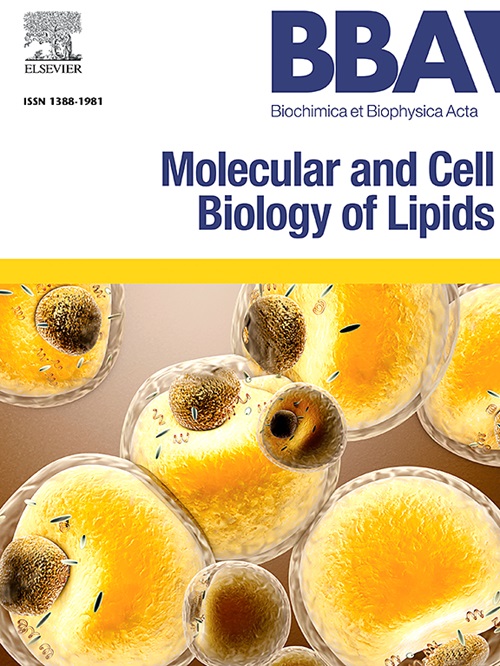多供体间充质干细胞在骨分化过程中的脂质代谢适应。
IF 3.3
2区 生物学
Q2 BIOCHEMISTRY & MOLECULAR BIOLOGY
Biochimica et biophysica acta. Molecular and cell biology of lipids
Pub Date : 2025-08-07
DOI:10.1016/j.bbalip.2025.159680
引用次数: 0
摘要
间充质干细胞(MSC)的骨分化伴随着重要的脂质代谢适应,可能揭示相关的生物标志物和潜在的骨诱导物种。然而,高供体可变性仍然是生物标志物鉴定的挑战。这项工作揭示了三个独立供体的人类脂肪组织间质干细胞(hAMSC)的共同脂质特征,使用非靶向核磁共振波谱方法。结果表明,骨分化诱导的酯化胆固醇增加优先富集于较短的单不饱和脂肪酸(MUFA)和含有较长脂肪酸(FA)的甘油三酯,两者都与细胞质中脂滴形成增加一致。膜适应涉及磷脂酰胆碱(PtdCho)和磷脂酰乙醇胺(PtdEtn)的水解,可能允许随后的多不饱和FA掺入(增强膜流动性)并促进过氧化FA的去除,同时产生无机磷酸盐(Pi)用于矿化。PtdCho水平似乎与肌酸-磷酸肌酸轴密切相关,反映了对Pi生成的共同贡献。MUFA似乎也是β-氧化的首选底物,显然与抗氧化机制有关。上述代谢效应表明,在三个供体中存在共同的途径调节,ALP、胶原蛋白、抗氧化酶、LDL和HSP27上调,ERK 1/2(在第7天显著上调)、精氨酸酶和空泡H+- atp酶下调。值得注意的是,提出的与供体无关的脂质特征使得骨分化细胞的检测准确率接近90% %,突出了不同脂质家族之间复杂的相互作用,酯化胆固醇、甘油三酯和磷脂成为骨分化的主要参与者。本文章由计算机程序翻译,如有差异,请以英文原文为准。

Lipid metabolic adaptations of multi-donor mesenchymal stem cells during osteodifferentiation
Mesenchymal stem cell (MSC) osteodifferentiation is accompanied by important lipid metabolic adaptations, which may reveal relevant biomarkers and potential osteoinductive species. However, high donor variability remains a challenge for biomarker identification. This work unveiled shared lipid features of human adipose-tissue MSC (hAMSC) for three independent donors, using an untargeted NMR spectroscopy methodology. The results showed that osteodifferentiation induced increases in esterified cholesterol preferentially enriched in shorter monounsaturated fatty acids (MUFA), and triacylglycerides containing longer fatty acids (FA), both consistent with increased lipid droplet formation in the cytosol. Membrane adaptations involved hydrolysis of phosphatidylcholine (PtdCho) and phosphatidylethanolamine (PtdEtn), possibly to allow subsequent polyunsaturated FA incorporation (to enhance membrane fluidity) and facilitate removal of peroxidized FA, while originating inorganic phosphate (Pi) for mineralization. PtdCho levels seem closely linked to the creatine-phosphocreatine axis, reflecting a shared contribution to Pi generation. MUFA also appeared to serve as preferential substrates for β-oxidation, apparently in association with antioxidative mechanisms. The above metabolic effects were indicative of a common pathway modulation in the three donors, with predicted upregulation of ALP, collagen, antioxidant enzymes, LDL, and HSP27, and downregulation of ERK 1/2 (notably upregulated at day 7), arginase, and vacuolar H+-ATPase. Notably, the proposed donor-independent lipid signature enabled the detection of osteodifferentiating cells with nearly 90 % accuracy, highlighting the complex interplay among different lipid families, with esterified cholesterol, triacylglycerides, and phospholipids emerging as main players in osteodifferentiation.
求助全文
通过发布文献求助,成功后即可免费获取论文全文。
去求助
来源期刊
CiteScore
11.00
自引率
2.10%
发文量
109
审稿时长
53 days
期刊介绍:
BBA Molecular and Cell Biology of Lipids publishes papers on original research dealing with novel aspects of molecular genetics related to the lipidome, the biosynthesis of lipids, the role of lipids in cells and whole organisms, the regulation of lipid metabolism and function, and lipidomics in all organisms. Manuscripts should significantly advance the understanding of the molecular mechanisms underlying biological processes in which lipids are involved. Papers detailing novel methodology must report significant biochemical, molecular, or functional insight in the area of lipids.

 求助内容:
求助内容: 应助结果提醒方式:
应助结果提醒方式:


